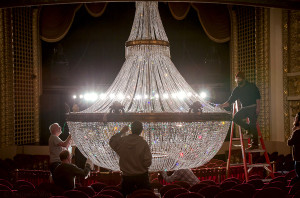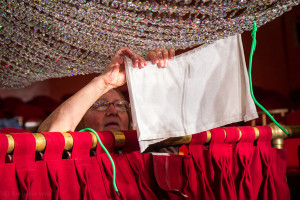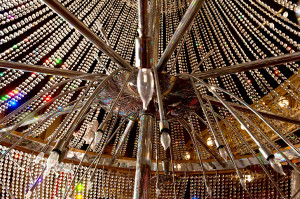Short history of the chandelier
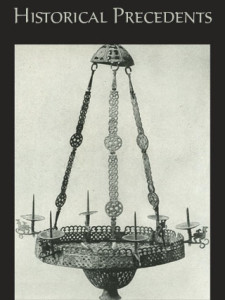 Yeah, seriously, we decided to write on this topic. What the chandelier is, where did it came from and how it has changed over time. Of course, it is born of man’s need of light and the necessity of it to be set high in order to illuminate the space well. Candles, however, were not particularly cheap, and each chandelier needs at least a few. The construction of wood or wrought iron also was not for free and therefore the earliest chandeliers were a privilege of the rich. In the common case they represented a wooden cross with a number of spikes, on which the candles were placed. The whole thing was lifted at the appropriate height through the use of a chain or rope anchored to a hook. Chandeliers were moved from room to room depending on where they were needed.
Yeah, seriously, we decided to write on this topic. What the chandelier is, where did it came from and how it has changed over time. Of course, it is born of man’s need of light and the necessity of it to be set high in order to illuminate the space well. Candles, however, were not particularly cheap, and each chandelier needs at least a few. The construction of wood or wrought iron also was not for free and therefore the earliest chandeliers were a privilege of the rich. In the common case they represented a wooden cross with a number of spikes, on which the candles were placed. The whole thing was lifted at the appropriate height through the use of a chain or rope anchored to a hook. Chandeliers were moved from room to room depending on where they were needed.
In the XV century chandelier changes its shape and already looks like a ring or crown and because of its price, remains part of the house (respectively palace) of the strengths of the day – aristocrats, merchants and clerics. It is symbol of prosperity and consequently luxury and status in society.
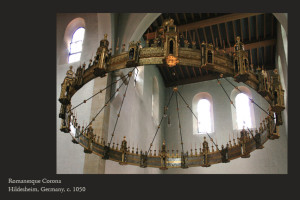 Before the XVIII century chandelier found a place in the homes of more and more traders, as it is now casted in metal molds with beautiful design with neoclassical motifs or is made of gilded wood with carvings. Clean lines and classic proportions dominate and mythological creatures are depicted.
Before the XVIII century chandelier found a place in the homes of more and more traders, as it is now casted in metal molds with beautiful design with neoclassical motifs or is made of gilded wood with carvings. Clean lines and classic proportions dominate and mythological creatures are depicted.
The next step of the journey of the chandelier is associated with the glass production development. In 1676 in England George Ravenscroft developed clear lead crystal glass (also known as flint glass) adding lead oxide (in quantities of between 10 and 30%) which improved the appearance of the glass and made it easier to melt using sea-coal as a furnace fuel. This technique makes the material transparent and the glass easier to manipulate. Lead crystal become more accessible and thus crystal chandelier stepped on the scene. The light reflected by its crystal elements was stronger, denser and livelier. In XVIII century this type of lighting along with other glass goods came out the skillful hands of the Venetian and Bohemian masters (northern Czech Republic) who became famous and notable in history for their art.
 Bohemian masters were unsurpassed in their mastery in the refraction of light as a result of its game on the walls of the crystal prisms they created for their chandeliers.
Bohemian masters were unsurpassed in their mastery in the refraction of light as a result of its game on the walls of the crystal prisms they created for their chandeliers.
Venetian masters on their side were, especially those from Murano, relied on the unique quality of their main product – the glass. With its help they formed leaves, flowers and fruits of colored glass as a decoration to elements of blown glass, mounted on a metal frame. Their magnificent chandeliers were the result of huge amounts of time and craftsmanship. Murano and Bohemian glass chandeliers found their place in many churches, cathedrals, palaces, galleries, theaters … How many curiosities from the past they’ve seen and hide …
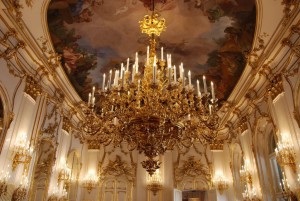 ВIn the middle of the XIX century, when gas began to be widely used for lighting, the chandeliers also undergo transformation.
ВIn the middle of the XIX century, when gas began to be widely used for lighting, the chandeliers also undergo transformation.
The same happened in 1890 with the appearance of electricity.
XVIII and XIX century the production of chandeliers continues, but widely available gas and electricity displace it from its status as a privilege and a mandatory attribute of the living and working spaces of the wealthy.
The end of the XX century purely aesthetic features of the chandelier prevail and shelter it in time, instead of burying it in oblivion, as an unnecessary light giver from the past, surrendered to electricity and gas.
Chandeliers, contrived by the old masters, are extremely expensive. Their maintenance is not easy – just imagine how are cleaned millions crystal pendants of a huge chandeliers, for example in the royal palace in Madrid. Not to mention the special detergents and other materials and tools that take part in this precise activity. For the chandeliers to shine today as they did in the old days and the art of their creators to amaze modern man with incredible mixture of simplicity and complexity.
Today we can buy modern lighting fixtures that look like the old times chandelier and bulbs resembling the flame of candles. Yes, we can not afford the luxury of times past, but contemporary likenesses are not bad at all. In fact, the purpose of the chandelier is the same today as it was years ago – to bring light in the darkness, luxury and comfort in the premises and coziness in the hearts.
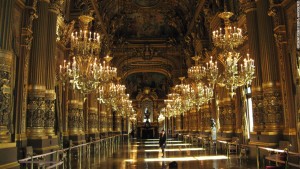 Why not make it part of your home? (If you still do not have a home for this bijou, choose one with us)
Why not make it part of your home? (If you still do not have a home for this bijou, choose one with us)
A suitable place to fall in love with it is Dolmabahce Palace in Istanbul, Turkey. There the biggest in the world crystal chandelier of Bohemian crystal hangs high above the visitors in the hall for official ceremonies. It is a gift from Queen Victoria, has 750 lamps and weighs 4.5 tons! By the way, at the same palace you can enjoy the world’s largest collection of crystal from Bohemia, Czech Republic and from Baccarat, France, and one of the official stairs of the palace is with crystal railings.
source: www.nwbstudios.com, www.urbanmilwaukee.com, www.raredelights.com, www.hankeringforhistory.com
